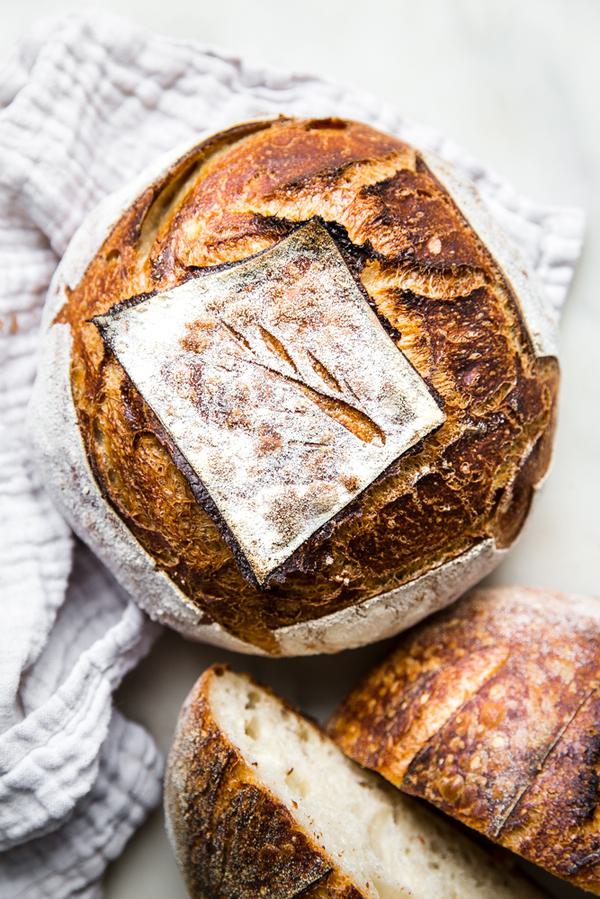Simple Recipes for Every Day
Sourdough Bread

- Serves: 8
- Prep Time: 30 min
- Cook Time: 1 hr 30 min
Ingredients
- 15g Active Sourdough Starter
- 120g lukewarm water for pre-ferment
- 240g lukewarm water for sourdough
- 105g whole wheat or all-purpose flour
- 375g all-purpose or bread flour, plus more for kneading
- 12g fine sea salt
Method
- Make the pre-ferment: In a large glass bowl, combine the active sourdough starter with lukewarm water (for pre-ferment). Stir in the 105 grams wholewheat (or all-purpose) flour until a shaggy dough forms, 1 to 2 minutes. Cover with plastic wrap and let sit at room temperature for about 12 hours.
- Once the pre-ferment has set for 12 hours, add lukewarm water (for sourdough) and, using your hands, mix until thoroughly combined. Add the all-purpose flour (or bread flour) and mix, using your hands, until a shaggy dough forms. Cover with plastic wrap and let sit for 1 hour (This rest period is called the autolyse).
- Once the dough has set for an hour, uncover and sprinkle all over with the salt. With wet hands, pinch and fold the dough until the salt is evenly distributed throughout the dough.
- With wet hands grab under the dough and pull up over the top of the dough, then press down on top, being careful not to overstretch the dough. Rotate the bowl and repeat the process 15 to 20 times. Cover with plastic wrap and let it rest for about 30 minutes.
- Repeat this process every 30 minutes, 6 times total. (The dough will begin to rise throughout the process.) Cover the dough and let sit for another 30 to 45 minutes.
- Gently turn the dough out onto a lightly floured surface to avoid losing any air bubbles. (Note: If you’re making more than one loaf, divide the dough accordingly. Use a scale to make sure all your loaves are the same size. Loaves straight from the fridge are easiest to work with. If baking more than one loaf, keep the other loaves in the refrigerator until ready to use.)
- Shape the dough. With floured hands, carefully pull the corners into the center of the dough to create a loose circle. Using a bench scraper, flip the dough over and let it rest, seam side down, for about 30 minutes.
- Meanwhile, generously dust a proofing basket with rice or all-purpose flour. (Note: If you don’t have a proofing basket, lay a tea towel flat and sprinkle it with flour. Use your hands to spread the flour into the entire surface of the towel and transfer it to a colander or medium bowl.)
- Dust the top of the loaf with flour, then flip it over. Grab a bottom edge of the dough, pull it up gently allowing gravity to stretch it, then fold it over onto the center of the dough, pressing it down to the center of the dough. Repeat alternating with the right and left sides of the dough. Lastly, grab the outer edge of the dough and press it into the center. Carefully roll the dough over so the smooth side is up. If it's not quite round, cup your palms around the dough and rotate it against the counter to shape it into a round loaf.
- Place the dough, seam-side up, in the proofing basket. Sprinkle the dough with flour and cover with a tea towel. Let the loaf rise at room temperature for 2 to 3 hours. (NOTE: If you plan to bake the dough the following day, let it rise at room temperature for 30 to 40 minutes, then transfer to the refrigerator for 12 to 24 hours.)
- Preheat the oven to 475°F with a rack in the center position.
- Place a piece of parchment paper on a flat surface. Carefully transfer the dough to the parchment and arrange seam side down. Using a lame, sharp knife, or razor, quickly slash a vent into the top of the dough. Immediately transfer the parchment and dough to a 5-quart Dutch oven using the corners of the parchment. Cover and bake for 25 minutes. Remove the lid and bake uncovered for 25 to 30 minutes more, or until the bread is browned and crusty. Let cool on a wire rack for at least 30 minutes before serving.
Notes
For multiple loafs:
Multiply the ingredients by the number of loafs desired.
Example — For 2 loafs:
- 30g - Active Sourdough Starter
- 240g - lukewarm water (for pre-ferment)
- 480g - lukewarm water (for sourdough)
- 210g - whole wheat or all-purpose flour
- 750g - all-purpose or bread flour
- 24g - fine sea salt